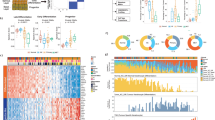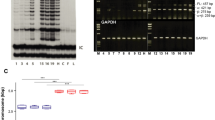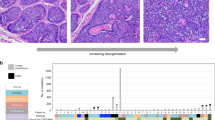Abstract
Non-melanoma skin cancers, in particular keratoacanthomas (KAs) and squamous cell carcinomas (SCCs), have become highly frequent tumor types especially in immune-suppressed transplant patients. Nevertheless, little is known about essential genetic changes. As a paradigm of ‘early’ changes, that is, changes still compatible with tumor regression, we studied KAs by comparative genomic hybridization and show that gain of chromosome 11q is not only one of the most frequent aberration (8/18), but in four tumors also the only aberration. Furthermore, 11q gain correlated with amplification of the cyclin D1 locus (10/14), as determined by fluorescence in situ hybridization, and overexpression of cyclin D1 protein (25/31), as detected by immunohistochemistry. For unraveling the functional consequence, we overexpressed cyclin D1 in HaCaT skin keratinocytes. These cells only gained little growth advantage in conventional and in organotypic co-cultures. However, although the control vector-transfected cells formed a well-stratified and orderly differentiated epidermis-like epithelium, they showed deregulation of tissue architecture with an altered localization of proliferation and impaired differentiation. The most severe phenotype was seen in a clone that additionally upregulated cdk4 and p21. These cells lacked terminal differentiation, exhibited a more autonomous growth in vitro and in vivo and even formed tumors in two injection sites with a growth pattern resembling that of human KAs. Thus, our results identify 11q13 gain/cyclin D1 overexpression as an important step in KA formation and point to a function that exceeds its known role in proliferation by disrupting tissue organization and thereby allowing abnormal growth.
This is a preview of subscription content, access via your institution
Access options
Subscribe to this journal
Receive 50 print issues and online access
$259.00 per year
only $5.18 per issue
Buy this article
- Purchase on Springer Link
- Instant access to full article PDF
Prices may be subject to local taxes which are calculated during checkout









Similar content being viewed by others
References
Arnold A, Papanikolaou A . (2005). J Clin Oncol 23: 4215–4224.
Ashton KJ, Weinstein SR, Maguire DJ, Griffiths LR . (2003). Arch Dermatol 139: 876–882.
Billingsley EM, Davis N, Helm KF . (1999). J Cutan Med Surg 3: 193–197.
Boukamp P . (2005). J Dtsch Dermatol Ges 3: 493–503.
Boukamp P, Petrussevska RT, Breitkreutz D, Hornung J, Markham A, Fusenig NE . (1988). J Cell Biol 106: 761–771.
Boukamp P, Popp S, Altmeyer S, Hulsen A, Fasching C, Cremer T et al. (1997). Genes Chromosomes Cancer 19: 201–214.
Boukamp P, Popp S, Bleuel K, Tomakidi E, Burkle A, Fusenig NE . (1999). Oncogene 18: 5638–5645.
Boukamp P, Stanbridge EJ, Foo DY, Cerutti PA, Fusenig NE . (1990). Cancer Res 50: 2840–2847.
Cerezo A, Stark HJ, Moshir S, Boukamp P . (2003). J Invest Dermatol 121: 110–119.
Clausen OP, Beigi M, Bolund L, Kolvraa S, Gjersvik PJ, Mork G et al. (2002). J Invest Dermatol 119: 1367–1372.
Di Cunto F, Topley G, Calautti E, Hsiao J, Ong L, Seth PK et al. (1998). Science 280: 1069–1072.
Euvrard S, Kanitakis J, Claudy A . (2003). N Engl J Med 348: 1681–1691.
Ewen ME, Lamb J . (2004). Trends Mol Med 10: 158–162.
Freedberg I, Eisen A, Wolff K, Austen KF, Goldspith L, Katz S et al. (1999). Fitzpatrick's Dermatology in General Medicine. McGraw-Hill Health Professional Division: New York.
Fu M, Wang C, Li Z, Sakamaki T, Pestell RG . (2004). Endocrinology 145: 5439–5447.
Hiyama H, Iavarone A, LaBaer J, Reeves SA . (1997). Oncogene 14: 2533–2542.
Hosokawa Y, Arnold A . (1998). Genes Chromosomes Cancer 22: 66–71.
Jin Y, Jin C, Salemark L, Wennerberg J, Persson B, Jonsson N . (2002). Cancer Genet Cytogenet 136: 48–52.
Jin Y, Martins C, Jin C, Salemark L, Jonsson N, Persson B et al. (1999). Genes Chromosomes Cancer 26: 295–303.
Johnson TM, Rowe DE, Nelson BR, Swanson NA . (1992). J Am Acad Dermatol 26: 467–484.
Jonason AS, Kunala S, Price GJ, Restifo RJ, Spinelli HM, Persing JA et al. (1996). Proc Natl Acad Sci USA 93: 14025–14029.
Kallioniemi A, Kallioniemi OP, Sudar D, Rutovitz D, Gray JW, Waldman F et al. (1992). Science 258: 818–821.
Lehman TA, Modali R, Boukamp P, Stanek J, Bennett WP, Welsh JA et al. (1993). Carcinogenesis 14: 833–839.
Lesage D, Troussard X, Sola B . (2005). Int J Cancer 115: 171–176.
Ling G, Persson A, Berne B, Uhlen M, Lundeberg J, Ponten F . (2001). Am J Pathol 159: 1247–1253.
Motokura T, Bloom T, Kim HG, Juppner H, Ruderman JV, Kronenberg HM et al. (1991). Nature 350: 512–515.
Nakazawa H, English D, Randell PL, Nakazawa K, Martel N, Armstrong BK et al. (1994). Proc Natl Acad Sci USA 91: 360–364.
Oyama T, Kashiwabara K, Yoshimoto K, Arnold A, Koerner F . (1998). Cancer Res 58: 2876–2880.
Parangi S, O’Reilly M, Christofori G, Holmgren L, Grosfeld J, Folkman J et al. (1996). Proc Natl Acad Sci USA 93: 2002–2007.
Popp S, Waltering S, Herbst C, Moll I, Boukamp P . (2002). Int J Cancer 99: 352–360.
Popp S, Waltering S, Holtgreve-Grez H, Jauch A, Proby C, Leigh IM et al. (2000). J Invest Dermatol 115: 1095–1103.
Quinn AG, Sikkink S, Rees JL . (1994). Genes Chromosomes Cancer 11: 222–225.
Rehman I, Takata M, Wu YY, Rees JL . (1996). Oncogene 12: 2483–2490.
Ren ZP, Hedrum A, Ponten F, Nister M, Ahmadian A, Lundeberg J et al. (1996). Oncogene 12: 765–773.
Rotzer D, Krampert M, Sulyok S, Braun S, Stark H-J, Boukamp P et al. (2006). Oncogene in press.
Schoop VM, Mirancea N, Fusenig NE . (1999). J Invest Dermatol 112: 343–353.
Serrano M, Hannon GJ, Beach D . (1993). Nature 366: 704–707.
Sherr CJ, Roberts JM . (1999). Genes Dev 13: 1501–1512.
Shoker BS, Jarvis C, Davies MP, Iqbal M, Sibson DR, Sloane JP . (2001). Br J Cancer 84: 1064–1069.
Stark HJ, Willhauck MJ, Mirancea N, Boehnke K, Nord I, Breitkreutz D et al. (2004). Eur J Cell Biol 83: 631–645.
Utikal J, Udart M, Leiter U, Kaskel P, Peter RU, Krahn G . (2005a). Cancer Lett 219: 197–204.
Utikal J, Udart M, Leiter U, Peter RU, Krahn G . (2005b). Int J Oncol 26: 597–605.
Waring AJ, Takata M, Rehman I, Rees JL . (1996). Br J Cancer 73: 649–653.
Zahnow CA . (2002). Breast Cancer Res 4: 113–121.
Acknowledgements
We would like to thank Dr Hans-Jürgen Stark for his support and Karin Greulich-Bode and Angelika Lampe for their help in editing the manuscript.
This work was supported by Sander Stiftung (1998.013.2) as well as EU grants QLK4-1999-01084 and LSHG-CT-2003-503447 (all to PB)
Author information
Authors and Affiliations
Corresponding author
Rights and permissions
About this article
Cite this article
Burnworth, B., Popp, S., Stark, HJ. et al. Gain of 11q/cyclin D1 overexpression is an essential early step in skin cancer development and causes abnormal tissue organization and differentiation. Oncogene 25, 4399–4412 (2006). https://doi.org/10.1038/sj.onc.1209474
Received:
Revised:
Accepted:
Published:
Issue Date:
DOI: https://doi.org/10.1038/sj.onc.1209474
Keywords
This article is cited by
-
Präzisionsmedizin in der Kopf-Hals-Onkologie durch den Einsatz innovativer Techniken
Die Onkologie (2023)
-
T-lymphocyte profiles differ between keratoacanthomas and invasive squamous cell carcinomas of the human skin
Cancer Immunology, Immunotherapy (2018)
-
The telomere profile distinguishes two classes of genetically distinct cutaneous squamous cell carcinomas
Oncogene (2014)
-
Stromal control of oncogenic traits expressed in response to the overexpression of GLI2, a pleiotropic oncogene
Oncogene (2009)
-
Cellular functions of 14-3-3ζ in apoptosis and cell adhesion emphasize its oncogenic character
Oncogene (2008)



